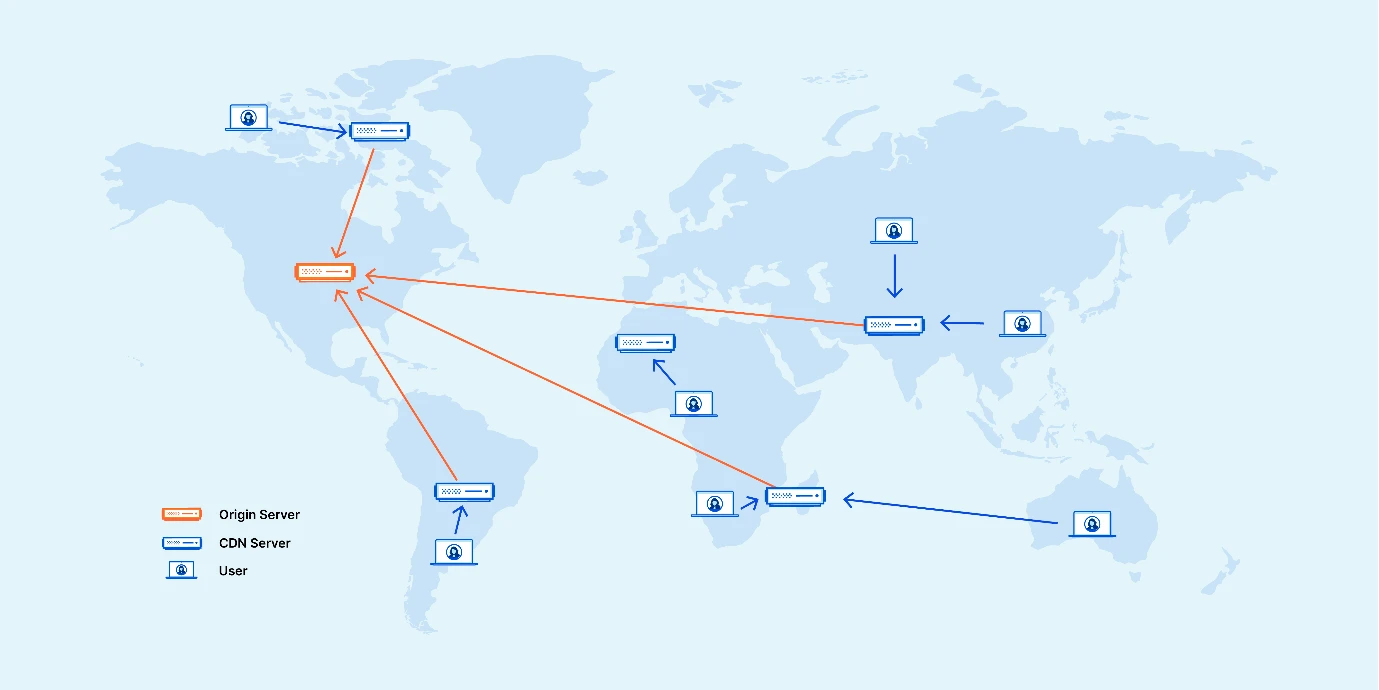A Content Delivery Network (CDN) enhances the security, reliability, and performance of a website by
strategically positioning web content in proximity to the user's location. It achieves this by
employing
a distributed network of servers and data centers, minimizing latency and efficiently delivering web
content to users.
Consider a Content Delivery Network (CDN) as similar to an ATM. If your only option is to withdraw
money
from a local bank, you might find yourself walking a considerable distance and enduring a lengthy
wait.
Conversely, with ATMs scattered on nearly every street corner, you can swiftly and effortlessly
withdraw
money at your convenience.
CDNs prove particularly beneficial for businesses heavily dependent on web traffic. Major players in
the
online sphere, such as video streaming platforms like Netflix, social media giants like Facebook,
and
the e-commerce behemoth Amazon, leverage CDNs to efficiently distribute content to their end users.
A well-configured CDN can play a crucial role in safeguarding websites against various malicious
attacks, including Distributed Denial of Service (DDoS) attacks.
How does a CDN work?
A content delivery network relies on three types of servers.
- Origin servers:- Origin servers serve as the authoritative source for the
original
versions of content. When updates are required, modifications are made directly on the origin
server.
The origin server can be under the ownership and management of the content provider, or it might
be
hosted within the infrastructure of a third-party cloud provider, such as Amazon's
AWS S3 or Google
Cloud Storage.
- Edge servers:- Edge servers, situated in diverse locations globally referred to
as
"points of presence" (PoPs), play a pivotal role in content delivery. These servers within PoPs
cache
content obtained from the source server and handle the distribution of this content to nearby
users.
User requests for access to content are routed to a copy stored on the edge server closest to
their
geographical location. Upon expiration of the cached content, the edge server initiates a request
for
updated content from the origin server. These CDN edge servers are typically owned or managed by a
CDN
hosting provider.
-
DNS servers:- The Domain Name System (DNS) servers have a vital role in managing
and
assigning IP addresses to both source and end servers. When a user sends a request to the central
server, the DNS server responds by furnishing the name of the partner edge server, thereby
optimizing
subsequent processes for increased speed and efficiency.
A significant portion of internet content is distributed through Content Delivery Networks (CDNs).
Here's a practical overview of how it operates:
If you reside in Mumbai and wish to access the website of a London-based store hosted on a server in
the
UK, the request may experience delays as it traverses the Atlantic. To address this issue, a Content
Delivery Network (CDN) stores cached copies of the London website's content in various global
locations
known as Points of Presence (PoPs). These PoPs house independent caching servers and are tasked with
delivering the website content to users in proximity to locations such as Mumbai.
To ensure an optimal viewing experience, CDNs perform two crucial functions.
- Reduce latency: Latency refers to the delay encountered while attempting to
access
a webpage or video stream before your device completes loading. Despite being quantified in
milliseconds, the apparent delay can give the sense of an extended wait and might lead to loading
issues or interruptions. To address latency, specific content delivery approaches concentrate on
minimizing the geographical distance that content needs to traverse. Consequently, well-planned
and
strategically positioned Content Delivery Networks (CDNs) can markedly enhance the speed and
dependability of web content delivery by siting content in close proximity to the end users.
- Balance loads: A CDN orchestrates traffic to ensure an optimal online
experience
for all users accessing online content. It can be likened to directing real-world traffic. While
the
fastest route from point A to point B is typically straightforward when there's no congestion, in
the
event of traffic buildup, diversifying directions becomes essential. This strategy might slightly
extend the journey time (or milliseconds when considering internet speed), but it prevents getting
stuck in traffic jams on the most direct route. Load balancing enables providers to effectively
handle
increasing demand, navigate competition, maintain high-quality customer service, and prevent
downtime.



